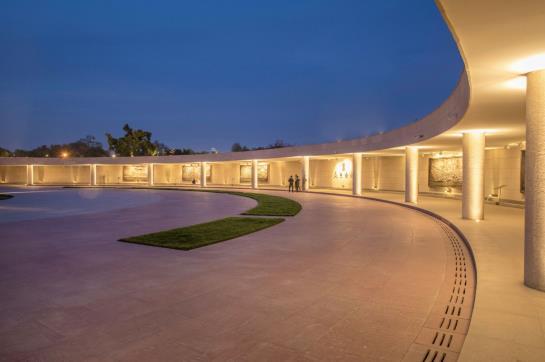
2 minute read
Figure 4-26 Establishing connection between the people and loved ones lost
from "SET IN STONE"
The central monument exemplifying the mighty power and strength of the Indian defense forces is well-complemented by the sunken space for people to sit and contemplate. The arena, with its lyrical narrative quality, the looming sky overhead, distant images of the Capitol Complex, and the pure greenery around was purely evocative.
Materials in such spaces (which are devoid of any embellishments) need special attention to be able to demand notice independently. The memorial, while at one face, has a befitting scale and monumentality for our past heroes, is relatable at the same time. Weaving through the Bougainvillea Garden, it fits well into the theme while maintaining its own individuality. While it portrays the perfect architectural symbolism, it does not lament but emanates an intangible, resilient sensitivity.
Advertisement
Keeping it simple, minimalist and conferring an ambience that can facilitate (and not create) the emotional connect between the visitors and the space can be an intense task for the designers which is excellently fulfilled in the design of Chandigarh war memorial.
Figure 4-26 Establishing connection between the people and loved ones lost
Frank Gehry had once stated that “Architecture has a lot of places to hide behind,” The Chandigarh war memorial defies this obstacle completely and remains a receptive addition in city beautiful.
4.3 COMPARITIVE ANALYSIS OF THE CASE STUDIES
4.3.1 IDEA: EXPRESSION OF REMEMBERANCE
The National War Memorial is the spatial manifestation of the idea of rebirth, gestated on the stories of, the life and struggle of unsung soldiers who have sacrificed themselves for the sake of nation. Culminating the Raj Path of the Lutyens Delhi, behind the India gate, this semi-subterranean intervention, spreads over 42 acres in the C- hexagon, retaining the identity as “people’s place” and embracing the memory of love, affection and pain. Each fallen soldier is imagined as a brick in the process of nation building and arranged as series of concentric rings, symbolizing the act of protection, sacrifice and bravery culminating in the immortal presence in the form of eternal flame.
The memorial, while at one face, has a befitting scale and monumentality for our past heroes, is relatable at the same time. Weaving through the Bougainvillea Garden, it fits well into the theme while maintaining its own individuality. While it portrays the perfect architectural symbolism, it does not lament but emanates an intangible, resilient sensitivity.
4.3.2 CONCEPTUAL FORM
The National War Memorial is planned as Concentric circles of different emotions namely Circle of Protection (Rakshak chakra) , Circle of Bravery (Tyag Chakra), Circle of Bravery (Veer Chakra) and Circle of Immortality (Amar Chakra). Each circle serves different functions. These circles have common Focal point which is a slightly sunken platform. The central focus is the obelisk containing the Amar Jawan Jyoti. The central obelisk is the most important part of the memorial as it exemplifying the mighty power and strength of the Indian defense forces.










